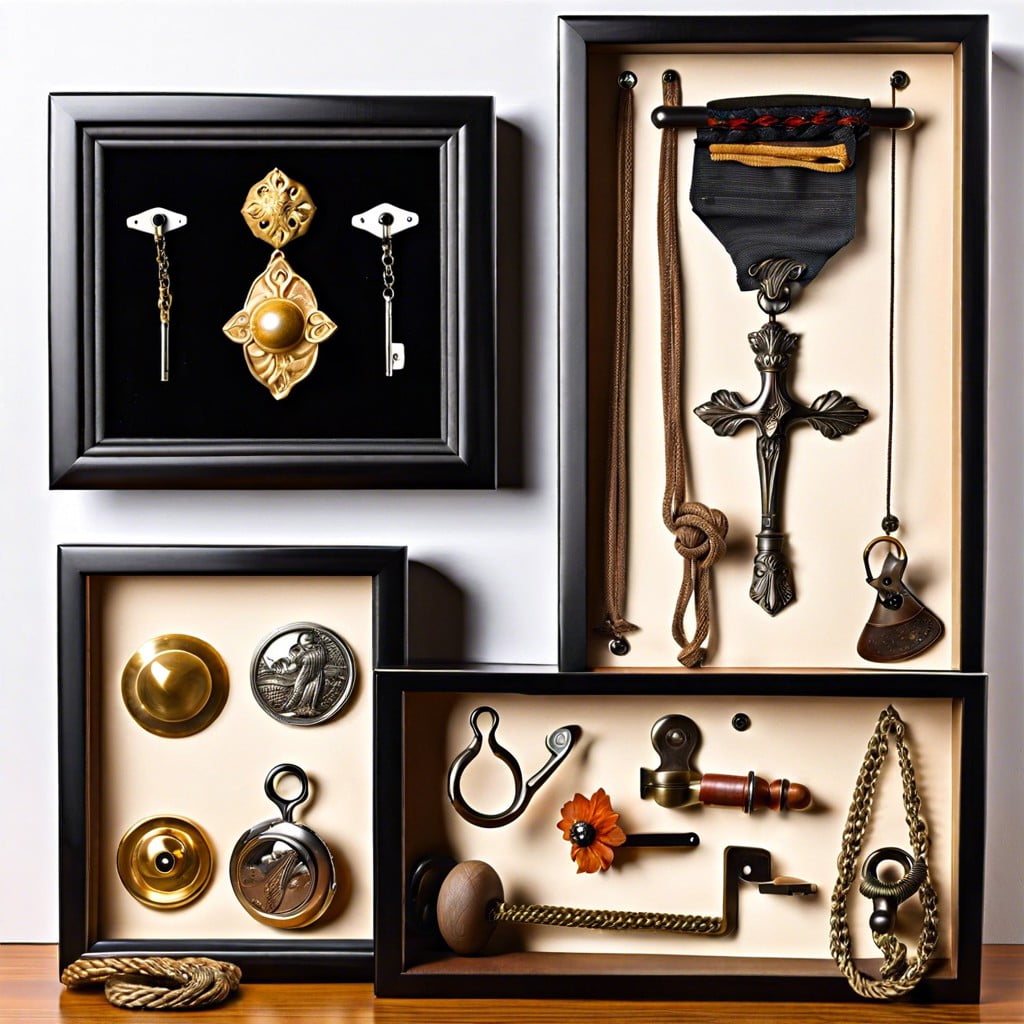Last updated on
Mastering the art of hanging a shadow box creates eye-catching three-dimensional displays, because each uniquely arranged box tells a personal story and elevates the aesthetics of any wall.
Hanging a shadow box on a wall can be an effortless task with the right know-how. Shadow box ideas provide an excellent display for your unique keepsakes and decorative items while adding depth and interest to any room’s decor.
We’ll guide you through every step of the process. From the necessary tools and materials, selecting the perfect location, securing it safely, to the final step of admiring your perfectly hanged shadow box.
Your cherished mementos will soon be front and center, appealingly presented inside a stylish shadow box. Just follow along to discover all the necessary tips and tricks.
Key takeaways:
- Consider visibility, lighting, wall space, surroundings, and accessibility when selecting the location.
- Accurately gauge the weight of the shadow box for selecting the appropriate hanging hardware.
- Mark the wall for placement and use a level for precise alignment.
- Drill or hammer anchors into the wall for secure mounting.
- Secure the shadow box on the wall and make final adjustments for aesthetics and stability.
Selecting the Right Location for Your Shadow Box

Consider the following points when choosing a location for your shadow box:
- Visibility: Opt for a spot that can be easily viewed from different angles in the room.
- Lighting: Choose an area with adequate lighting to highlight the contents of the shadow box, but avoid direct sunlight that can fade the items inside.
- Wall Space: Ensure the wall space is ample for the shadow box to fit without crowding or obstruction by furniture.
- Complementary Surroundings: Place the shadow box amongst related decor elements that enhance its appearance and relevance in the room’s theme.
- Accessibility: Position it at a height where it can be easily reached for cleaning and rearranging items inside the box.
Determining the Weight of the Shadow Box

Accurately gauging the weight of your shadow box is vital for selecting the right hardware that can support it safely on the wall. Use a bathroom scale for a straightforward approach to weigh the box. If it’s too light to register, place it on the scale along with an item of known weight and subtract the latter from the total. Keep in mind, any additions to the box’s contents will add weight, so always round up or factor in extra pounds when picking out hardware.
This step ensures the longevity of your display and the safety of your wall.
Choosing the Appropriate Hanging Hardware

Assess the weight of your shadow box to select a suitable hanger; options include picture hooks, D-rings, wire, and sawtooth hangers for lighter pieces.
Heavier units may require wall anchors or toggle bolts.
For drywall installations, drywall anchors ensure secure mounting without studs.
If attaching to a stud, a screw directly into the wood provides ample support.
For optimal safety and stability, consider using two hangers spaced evenly apart, which distribute the weight and keep the box level.
Always refer to the manufacturer’s recommendations for specific hardware suggestions.
Marking the Wall for Placement

Before you begin marking, position the shadow box against the wall and choose the ideal height for display, taking into account eye level and room aesthetics.
Once you’ve decided on the spot, turn the box around and measure the distance from the top of the box to the hanging hardware.
Transfer this measurement to the wall from your chosen height.
Next, use a pencil to lightly mark where the hardware will connect.
If your shadow box has two hanging points, ensure they are equidistant from the center for balance.
To prevent any mistakes, use a ruler or measuring tape for accuracy and a level to guarantee the markings are even, ensuring your shadow box will hang straight.
Using a Level for Precise Alignment
To ensure your shadow box hangs evenly, aligning it with a level is crucial:
- Place the level on top of the frame, adjusting the box until the bubble indicates a balanced position.
- For larger shadow boxes, use a longer level to span more of the frame for greater accuracy.
- If mounting alone, temporarily tape the level to the frame to keep it in place while you adjust.
- For wire-backed boxes, ensure the wire is taut and the level is used when the wire is in hanging position.
- Mark the desired position on the wall once the level shows an even alignment.
This precise alignment prevents the shadow box from appearing tilted and ensures a professional-looking result.
Drilling or Hammering Anchors Into the Wall
Begin by donning safety goggles to protect your eyes from debris. If the wall is made of drywall and you’ve determined where the studs are, you may not need wall anchors for lighter shadow boxes. For heavier items or when a stud isn’t available, wall anchors are essential to provide sufficient support.
For drywall:
- 1. Hold the drill perpendicular to the wall and drill a hole slightly smaller than the anchor. This ensures a snug fit.
- 2. Gently tap the anchor into the hole with a hammer until it is flush with the wall surface.
For masonry walls:
- 1. Use a masonry bit to drill a hole into the wall. The bit should correspond to the size of the wall anchor.
- 2. Insert the anchor and tap it in until secure.
After inserting the anchors, attach the provided screws, ensuring they are tight enough to support the shadow box but leaving enough of the screw head exposed to hang it securely.
Securing the Shadow Box On the Wall
With anchors firmly in place, align the shadow box’s mounting hardware with the wall anchors. Hold the box close to the wall, tilting slightly if necessary to hook it onto the screws or nails. Gently lower the box, ensuring that the hanging hardware fully engages with the anchors.
Apply slight pressure to the box to make sure it is secure. The shadow box should not wobble or shift; if it does, recheck your anchors and the fit of the hardware. A sturdy mount means your display is safely showcased on the wall, ready for admiration.
Final Adjustments for Aesthetics and Stability
Once your shadow box is mounted, step back to view it from different angles to ensure it’s visually appealing. Minor adjustments may be necessary to align it with other elements in the room for a harmonious look. If the box seems askew, gently nudge it until it appears balanced.
Check the stability by lightly pressing the corners. If there’s any movement, double-check that your hardware is tight and secure. For heavier shadow boxes, ensure that wall anchors are holding firm to prevent shifting over time. If your shadow box has a glass front, clean it to remove fingerprints or dust that may have collected during the hanging process, ensuring that your displayed items are clearly visible.
Finally, adjust the lighting in the room or add spotlights to highlight the shadow box, emphasizing its contents and transforming it into a focal point of your decor.
(Note: The Provided List Is Already Concise and Useful and Contains Less Than 20 Items. No Changes Were Made.)
When choosing the right location, consider both the visual balance of the room and the practicality of the spot. Keep in mind the proximity to other wall hangings and the overall flow of the space.
A shadow box should be displayed at eye level, generally 57 to 60 inches from the floor to the center of the frame, which is the standard height for most art galleries. Avoid areas with direct sunlight that could fade the contents or cause unwanted glare.
Check if the chosen wall can support the weight of the shadow box, especially if it’s a heavy piece. Be mindful of the traffic flow in the room to prevent the shadow box from being bumped or knocked off the wall.
FAQ
Can you hang a shadow box with command strips?
No, you cannot hang a shadow box with command strips as they’re not recommended for such use.
How do you mount patches in a shadow box?
To mount patches in a shadow box, either a strong adhesive for permanent installation or temporary options such as double-sided tape, Velcro tape, or Velcro dots can be utilized depending on the type of surface.
What tools are needed to securely hang a shadow box?
To securely hang a shadow box, one would need a level, a hammer, appropriate wall anchors, and nails or screws.
How can you arrange objects optimally in a shadow box for the best visual effect?
For optimal visual effect in a shadow box, arrange objects by considering balance and harmony, grouping related items together, and ensuring important pieces are in a focal point, while others provide texture, depth or color.
What is the ideal location and height for hanging a shadow box in a room?
The ideal location for hanging a shadow box is at eye level, typically between 57 to 64 inches from the floor, in a well-lit area where it is not exposed to direct sunlight.




